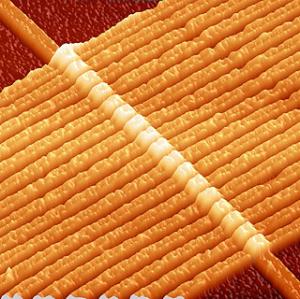Cut PC energy use by 99%: Use a memristor


PC and gadget users - ie, anyone reading this story - collectively contribute to global CO2 emissions probably more than the airline industry does. Every time billions of us plug in, recharge, refresh, retrieve, reboot, download, upload, store, save, italicize, underline, boldface, capitalize, minimize, maximize, delete, surf, click or stream (you get the picture), we are drawing energy.
Now, a London-led research team thinks it has found a way to slash the energy consumption of at least some of our computing functions by 99 percent.
The key: Use a different material to make "memristors."
Memristors are the elusive electronics components that are supposed to soon replace other semiconductor and memory technologies to support faster and denser memory. They are both memory chips and resistors rolled into one circuit.
Leon Chua at the University of California Berkeley first hypothesized memristors 41 years ago, but no one successfully made a working laboratory version until 2008, when HP announced a breakthrough. Two years later, HP entered a joint venture with chip maker Hynix and targeted commerical production by 2013.
The problem, as a story on the BBC website points out, is that memristors require "expensive or exotic materials."
University College London to the rescue! Forget the exotic materials. Instead, use a close relative of silicon called silicon oxides, says UCL's Anthony Kenyon, who led a collaborative research team from the UK, France and Spain.
"That would make them easy and cheap to integrate into existing manufacturing techniques," the BBC reports, in summarizing the team's findings.
The crew serendipitously stumbled upon the idea while looking into silicon for LEDs.
Kenyon and his student Adnan Mehonic discussed their work at the European Materials Research Society conference in Strasbourg, France last week.
"As they described ..., the energy required to switch the state of their devices - the energy it would take to store or retrieve a bit of information - is just a hundredth of that in existing flash memory, and significantly faster," the BBC writes.
In other words, you could potentially slash energy consumption by 99 percent every time you hit the "open file" or "save" button on your computer.
Multiply that by the number of PC and gadget junkies in the word, and the planet's CO2 footrpint could lose at least a couple of toes, if not a heel. This sounds like an idea worth kicking into action.
Note: An earlier version of this story stated that HP was the first to hypothesize memristors, in 1971. In fact Leon Chua of the University of California Berkeley was the first to describe a memristor. HP was the first to make one, decades after Chua's 1971 seminal paper. Corrected at 11:00 a.m. PDT, May 21.
More energetic chip, material and gadget insights on SmartPlanet:
- Bridge from gadget guilt: Intel's new chip slashes energy
- Extreme electronics: Goodbye silicon, hello oxides
- Graphene the Sequel: Graphyne. It’s flashier.
- Gadget guilt: If you’re reading this, you’re warming the planet
- Another step toward harnessing memristors (photos)
This post was originally published on Smartplanet.com